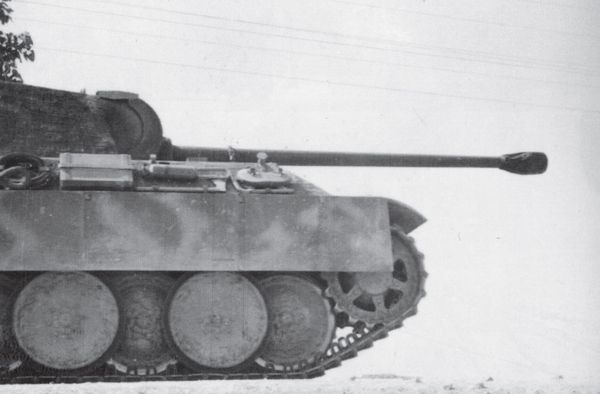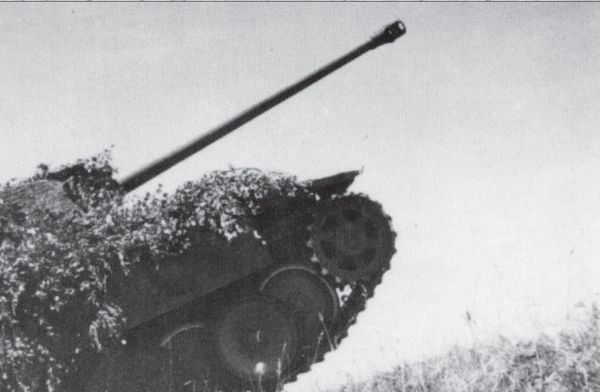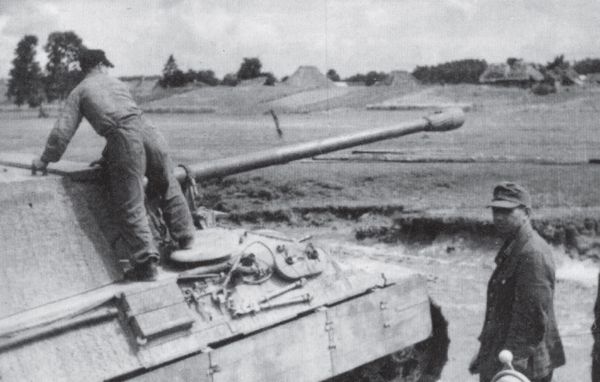Warszawa II (4 page)
Authors: Norbert Bacyk

A StuG 40 Sd Kfz 142/1 ausf G advancing toward the Soviets! The vehicle hails from Sturmgeschütz-Brigade 904, during July of 1944 in eastern Poland. (Leandoer & Ekholm archive)

At the same time, events at the front became increasingly intense. The 2nd Tank Army had reached Lublin even sooner than the headquarters' directive had planned. But during the fighting outside of Bystrzyca on the night spanning July 23-24, General Bogdanov was seriously wounded. His command was taken over by the tank army's chief of staff, General Aleksiej Radzjijevskij. On July 24, the 1st Belorussia Front's left flank, together with 3rd Guards Army from the 1st Ukrainian Front, crushed the German 4th Panzer-Army. The defeated divisions from the VIII Army-Corps retreated in chaos to the outskirts of BiaÅa Podlaska to the rearguard area of the 2nd Army. The decimated LVI Panzer-Corps, on the other hand, escaped by fleeing across the WisÅa opposite Lublin. In this way, a 70 kilometre wide gap was opened up in the German lines between PuÅaway and Åuków. This gap was filled by the 2nd Tank Army, the 8th Guards Army, the 47th Army and the 7th Cavalry Guards Corps. When Radzjijevskij took over command, there were no enemy forces worthy of mention standing between his armoured corps and Warsaw.

A crew loading ammunition onto a PzKpfw V Sd Kfz 171 “Panther” tank, Eastern Front, July 1944. (CAW)
An RSO with a 7.5 cm Pak 40 on a trailer parked in a corn field, July 1944. Behind it, three other units can be seen. All three hail from Panzer-jäger- Abteilung 49/4th Panzer-Division. (Leandoer & Ekholm Archive)

However, the situation outside of Siedlce was more complicated. On July 24, General Krjukov's rapid response forces approached the city. Seizing Siedlce and cutting off the road between Warsaw and Brest was a vital component of the plan to encircle the German 2nd Army. The defeated VI11 Army-Corps' retreat in an easterly direction towards BiaÅa Podlaska, suited Soviet plans “hand in glove.” Soon, however, the 11 th Tank Corps' frontline troops were subjected to heavy attack from the Luftwaffe. Aircraft from the German 6th Luftflotte carried out concentrated carpet and dive-bombing attacks on the stretched-out mechanised columns. General Weià made the decision to try and hold Siedlce at any price. He gave the order to call in the 3rd SS-Panzer-Division “Totenkopf ” and the 5th SS-Panzer-Division “Wiking,” which until then had been fighting north of Brest, in preparation for the battle. Transporting the whole of both divisions at such short notice was an impossibility (as late as July 17 the forces of the 3rd SS-Panzer-Division “Totenkopf” had been defending the isolated Grodno area), and therefore an improvised Kamfgruppe was sent south. The 5th SS-Panzer-division “Wiking” â for example â was split up with support from the grenadier regiment. And while Kamfgruppe “Westland” (SS-Panzer-Regiment 10 “Westland”, the 1st Battalion from SS-Panzer-Regiment 5 and elements of the SS-Panzer-Artillery-Regiment 5) remained at the north front in the vicinity of the Bug River, other units began to slowly wend their way south. Holding the overland road toward Siedlce was a key concern for the 2nd Army's right flank, because on July 22 the Soviet 65th and 28th Armies had reached the Bug River close by Siemiatycze. This meant that now the defenders of Brest â the XX Army-Corps and the VIII Arm-Corps, who had also been transported there â could only retreat to the west through Siedlce and the nearby SokoÅow Podlaski.

Soviet tanks of model M4A2 “Sherman” probably from the 8th Tank Guards Corps, along with a Polish infantry column, July 1944.” (RGAKFD)
Now that troops from Heeresgruppe “Mitte” and those from “Nord Ukraine” had been isolated from one another, OKH made the decision to redraw the operational boundaries for the armies fighting at the front. The 4th Panzer-Army received orders to hold the line along the WisÅa south of Radom, while operational responsibility for the terrain north of this town fell on the shoulders of Heeresgruppe “Mitte.” In this way the VIII Army-Corps came to be incorporated into the 2nd Army. However, this army did not have sufficient troops to man the Warsaw defence line. The army command, with a great deal of difficulty, managed to organise the defence of Siedlce with its rearguard troops, but any chance of sending troops 70 km west towards Warsaw was out of the question! For this reason OKH handed over responsibility for the defence of the WisÅa River's central portion and of Warsaw to the reorganized 9th Army. General Nicolaus von Vormann, who had command of this army, received orders to hold the front from Pulawy to Minsk Mazowiecki, where his left flank would establish contact with General WeiÃ's forces.
General von Vormann was an experienced commander, but it seemed that the mission he had been handed was impossible to carry out. On July 25, when he reported to Heeresgruppe “Mitte” that his staff had taken up their duties, there was not a single German division between PuÅawy and Siedlce. The road to Warsaw, as with the frontline along the WisÅa north of DÄblin, was not manned by even a single German soldier. To plug this enormous gap, OKH earmarked the 9th Army Parachute-Panzer-Division “Hermann Göring” which was still on route via rail from Italy, plus the 17th and the 73rd Infantry-Divisions as well as the 174th Ersatz-Division. The Ersatz-Division had, up to this point, been engaged with carrying out missions in the occupied General-government, so that it could, in principle, be directly sent into battle between DÄblin and PuÅawy. Immediately following which, it could then be supported by the 17th Infantry-Division. Meanwhile, the 73rd Infantry-Division together with Parachute-Panzer-Division “Herman Göring” were despatched to Warsaw's outskirts. The 60 kilometres that separated these two forces stood, for all practical purposes, completely undefended.

The following four pictures show Panther tanks from the 1 st Panzer-Regiment 35, 4th Panzer-Division, July 1944 east of Warsaw in the war zone.

A Panther from a ground perspective.
A Panther climbing over a ditch.


A Panther wades across a waterway.